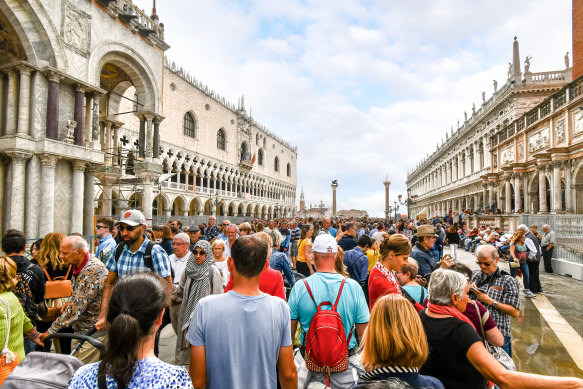Opinion
Some European cities are punishing tourists, others are rewarding them
Lee Tulloch
Travel columnistThis time last year, I was in Venice.
It wasn’t the optimum time of the year. August is the January of Europe – the height of summer holidays, when residents flee their cities and leave them to tourists.
No wonder the locals leave. It’s hotter than ever. Europe is the world’s fastest-warming continent and temperatures are rising at twice the global average, according to the EU’s climate agency.
Since June this year, Italy has been engulfed in consecutive heatwaves. Seventeen cities were placed on red alert, including Rome and Venice.

Cruise ship passengers crowd the walkway at the Doge’s Palace in Piazza San Marco.Credit: iStock
But this doesn’t dent the popularity of these cities for visitors. Cram 70,000 extra people each day into those narrow Venetian streets, and it’s a steam bath.
I was one of those extra people last year. I tried to be a good guest. I minimised my presence by sticking to less-visited neighbourhoods and steered well clear of St Mark’s Square. But Venice needs to be seen in person, so I don’t blame first-timers for wanting to see the famed attractions.
After my visit (although not because of it, I hope), Venice introduced an entry fee of €5 ($8.20) for day-trippers to the city’s historic centre. Many tourists come off cruise ships, go on pre-paid tours, stick to their group, clog streets, and spend little money while on land.
The gondoliers and souvenir stall owners are probably the only Venetians happy to see tourists in summer – the disdain for day-trippers is palpable everywhere else. Even when visitors stay for a night or two in a central hotel, the endless sound of suitcase wheels being dragged over cobblestones drives locals mad.
Venice’s tourist tax scheme ended a few weeks ago, having raised more than €2 million for essential services.
But the scheme did little to reduce visitor numbers on peak days, according to city data. During the first 11 days that the tax was imposed, an average of 75,000 visitors were recorded – 10,000 more a day than a similar period in 2023.
Probably €5 wasn’t enough dissuasion. Especially when that’s not much more than the price of a bottle of water there. But would €10 have worked better? Or even €50?
Thousands of frustrated Barcelona residents have spent this summer protesting the noise, crowds, litter and disrespectful behaviour of tourists, some using water pistols to let visitors know where they’re not wanted. About 25,000 cruise passengers flood into the narrow streets of the Gothic Quarter each day in the sizzling heat of summer.
Like Venice, Barcelona’s economy is dependent on tourism. But it’s nuanced. Tourists demand the kind of services, like souvenir shops and kiosks, that crowd out the practical amenities residents need. Market stalls increasingly cater for tourists with prepared food, for instance, rather than the produce residents use in daily life.
Too many visitors can make life hell for people who make picturesque and historic areas their home. And they’re getting little economic benefit from it unless they’re directly involved in tourism.
But maybe the carrot rather than the stick might be more effective?
This summer, Copenhagen dangled a carrot with the introduction of CopenPay, an innovative program that offered tourists rewards for participating in activities such as picking up litter, cycling and using public transport.
Designed to offset the environmental burden of tourism by getting visitors to act more sustainably at their destination, the scheme rewarded participants with perks from free lunches and drinks to free museum entry and kayak hire.
Tourists redeemed rewards at 24 participating businesses by showing evidence of green actions, such as train tickets or photographs of themselves biking.
CopenPay has concluded for this summer, but plans are to make it a year-round program.
While it doesn’t specifically address tourist numbers, it does go to visitor behaviour. In Barcelona, they dislike the crowds, but they hate the drunken, noisy, disrespectful behaviour more. It’s the same for any destination that has a reputation as a party place, whether it’s Ibiza or Byron Bay.
Clean, green and cooler Copenhagen probably attracts visitors who are open to cycling, walking or volunteering in a communal garden for rewards – even collecting rubbish if it’s made into a fun activity.
With many cities at crisis point over the way tourism is fraying the fabric of their communities, all ideas are welcome.
Sign up for the Traveller Deals newsletter
Get exclusive travel deals delivered straight to your inbox. Sign up now.